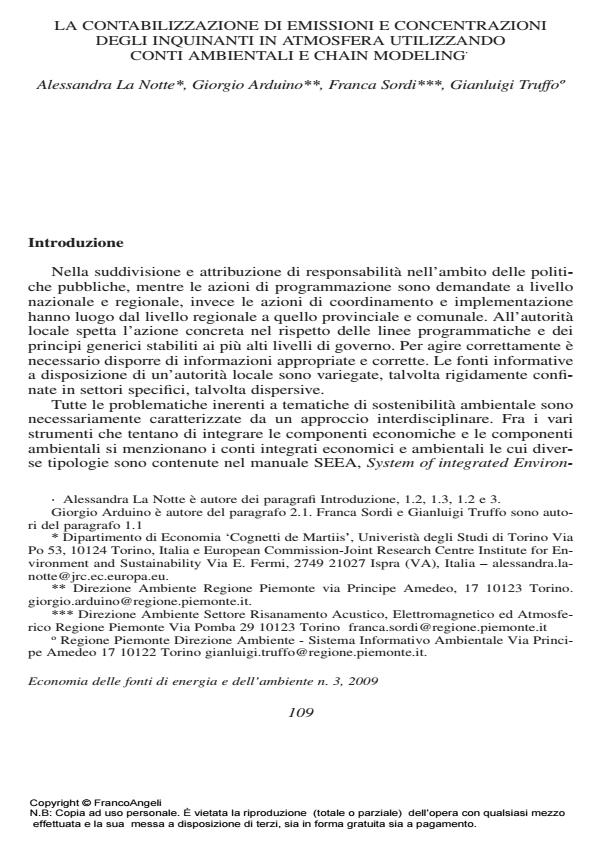La contabilizzazione di emissioni e concentrazioni degli inquinanti in atmosfera utilizzando conti ambientali e chain modeling
Journal title ECONOMIA DELLE FONTI DI ENERGIA E DELL’AMBIENTE
Author/s Alessandra La Notte, Giorgio Arduino, Franca Sordi, Gianluigi Truffo
Publishing Year 2010 Issue 2009/3
Language Italian Pages 31 P. 109-139 File size 2632 KB
DOI 10.3280/EFE2009-003006
DOI is like a bar code for intellectual property: to have more infomation
click here
Below, you can see the article first page
If you want to buy this article in PDF format, you can do it, following the instructions to buy download credits

FrancoAngeli is member of Publishers International Linking Association, Inc (PILA), a not-for-profit association which run the CrossRef service enabling links to and from online scholarly content.
Accounting for air emissions and concentrations by using environmental accounts and chain modeling - Sustainability issues require multidisciplinary approaches. Integrated environmental and economic accounts could be a useful support for policy makers for analysis and planning purposes. Applied at local level, some environmental accounting modules could target specific purposes related to the territory and its peculiarities. This case study applied in Piemonte (Italy) shows that hybrid flow accounts (namely NAMEA) at regional and sub-regional level are feasible and reliable. The focus on the origin of pollutants at different administrative levels can considerably change the weight of specific production sectors as drivers for the emissions in specific areas and thus the action to be implemented to target those pollutants. The link between origin and destination for air emissions (although non-linear) is allowed by using the same emission inventory database. The regional, provincial and municipal levels compiled for the ‘origin’ of air emissions assign the emission sources according to NACE code and thus to economic and employment data. Through the municipality level the emission data can be linked to the geo-referenced results of simulation models (the ‘destination’) that take into account meteorological conditions, chemical transformation, dispersion and geomorphologic characteristics of the territory. This application shows: how the results of environmental modeling can be connected to economic data into a comprehensive framework to be used by local planners and policy makers, how important is GIS for modeling purposes and for economic-environmental integration processing, and how the local level application only can provide feasible and useful applications for some environmental accounting modules.
Keywords: Environmental accounting, NAMEA, air emission, air concentration, chain modeling
Jel codes: Q53, Q56, Q58
Alessandra La Notte, Giorgio Arduino, Franca Sordi, Gianluigi Truffo, La contabilizzazione di emissioni e concentrazioni degli inquinanti in atmosfera utilizzando conti ambientali e chain modeling in "ECONOMIA DELLE FONTI DI ENERGIA E DELL’AMBIENTE" 3/2009, pp 109-139, DOI: 10.3280/EFE2009-003006